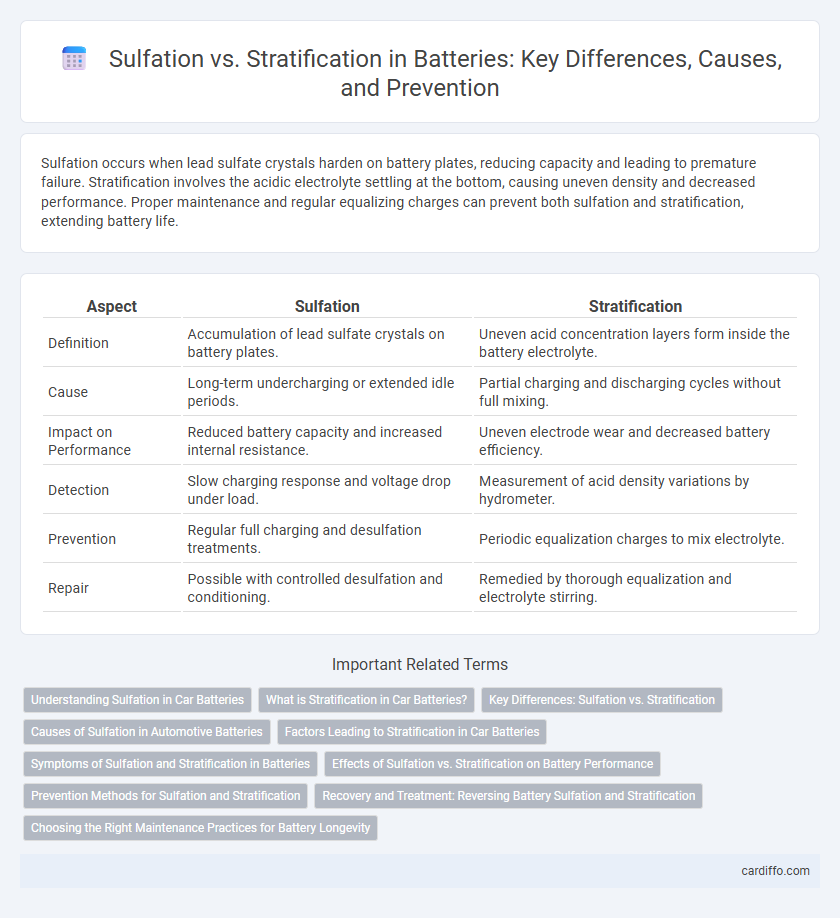Sulfation occurs when lead sulfate crystals harden on battery plates, reducing capacity and leading to premature failure. Stratification involves the acidic electrolyte settling at the bottom, causing uneven density and decreased performance. Proper maintenance and regular equalizing charges can prevent both sulfation and stratification, extending battery life.
Table of Comparison
| Aspect | Sulfation | Stratification |
|---|---|---|
| Definition | Accumulation of lead sulfate crystals on battery plates. | Uneven acid concentration layers form inside the battery electrolyte. |
| Cause | Long-term undercharging or extended idle periods. | Partial charging and discharging cycles without full mixing. |
| Impact on Performance | Reduced battery capacity and increased internal resistance. | Uneven electrode wear and decreased battery efficiency. |
| Detection | Slow charging response and voltage drop under load. | Measurement of acid density variations by hydrometer. |
| Prevention | Regular full charging and desulfation treatments. | Periodic equalization charges to mix electrolyte. |
| Repair | Possible with controlled desulfation and conditioning. | Remedied by thorough equalization and electrolyte stirring. |
Understanding Sulfation in Car Batteries
Sulfation in car batteries occurs when lead sulfate crystals form on the battery plates, reducing the battery's ability to hold and deliver charge efficiently. This condition often results from prolonged undercharging or extended periods of inactivity, causing a decline in overall battery performance and lifespan. Proper maintenance, including regular charging cycles and avoiding deep discharges, helps prevent sulfation buildup and ensures reliable battery operation.
What is Stratification in Car Batteries?
Stratification in car batteries occurs when the electrolyte separates into layers of different acid concentrations, typically with a stronger acid concentration at the bottom and a weaker concentration at the top. This phenomenon reduces the battery's efficiency by limiting the active chemical reactions necessary for proper energy storage and delivery. Preventing stratification involves regular battery maintenance, such as equalizing charges and ensuring full charge cycles to promote electrolyte mixing.
Key Differences: Sulfation vs. Stratification
Sulfation in batteries occurs when lead sulfate crystals build up on the battery plates, reducing capacity and increasing internal resistance, whereas stratification involves the separation of electrolyte layers, leading to uneven acid concentration and poor battery performance. Sulfation is primarily caused by long-term undercharging or extended discharge, while stratification results from shallow cycling and insufficient electrolyte mixing. Addressing sulfation often requires desulfation techniques or equalization charging, whereas stratification is mitigated through regular full discharges and proper agitation of the electrolyte.
Causes of Sulfation in Automotive Batteries
Sulfation in automotive batteries occurs when lead sulfate crystals harden on the battery plates, primarily due to prolonged undercharging or excessive discharge cycles. This buildup impedes the chemical reactions necessary for energy storage, reducing battery capacity and lifespan. Factors such as infrequent use, extended idle periods, and inadequate charging voltages significantly contribute to sulfation development.
Factors Leading to Stratification in Car Batteries
Stratification in car batteries primarily occurs due to uneven acid concentration, caused by insufficient battery charging and prolonged partial state of charge conditions. Temperature variations and low electrolyte agitation during battery operation also contribute significantly to the layering of acid within the cells. These factors inhibit proper chemical reactions, reducing battery efficiency and lifespan.
Symptoms of Sulfation and Stratification in Batteries
Sulfation in batteries manifests through symptoms such as reduced capacity, slower charging times, and an inability to hold a charge, often caused by lead sulfate crystals forming on the battery plates. Stratification symptoms include voltage imbalance between cells, decreased overall battery performance, and uneven electrolyte concentration due to acid layering. Both sulfation and stratification lead to early battery failure and require specific maintenance techniques to restore optimal functionality.
Effects of Sulfation vs. Stratification on Battery Performance
Sulfation causes lead-acid battery performance degradation by forming lead sulfate crystals that reduce active material surface area, leading to decreased capacity and increased internal resistance. Stratification results in acid concentration gradients within the battery, causing uneven corrosion and reduced efficiency due to inconsistent electrolyte mixing. Both sulfation and stratification significantly impair battery lifespan and power delivery but through distinct electrochemical mechanisms affecting charge acceptance and discharge rates.
Prevention Methods for Sulfation and Stratification
To prevent sulfation in batteries, maintaining a full charge and performing regular equalizing charges help dissolve lead sulfate crystals, thus preserving battery capacity and lifespan. Stratification prevention involves routine battery equalization and avoiding prolonged low state-of-charge conditions to ensure uniform electrolyte concentration and temperature. Implementing proper charging protocols and periodic maintenance cycles reduces risks of both sulfation and stratification, optimizing overall battery performance.
Recovery and Treatment: Reversing Battery Sulfation and Stratification
Battery sulfation occurs when lead sulfate crystals build up on the battery plates, reducing capacity and performance, but advanced desulfation techniques using controlled pulses of current can effectively break down these crystals and restore battery life. Stratification happens when electrolyte layers separate due to improper charging or prolonged idle periods, leading to uneven acid concentration and decreased efficiency; this can be treated by equalization charging, which circulates and homogenizes the electrolyte. Both recovery methods prolong battery lifespan, improve charge acceptance, and ensure optimal energy output in lead-acid battery systems.
Choosing the Right Maintenance Practices for Battery Longevity
Sulfation in batteries occurs when lead sulfate crystals harden on the plates, reducing capacity and causing permanent damage if not addressed. Stratification happens when electrolyte layers separate, leading to uneven acid concentration and corrosion in the lower plates. Implementing routine equalization charges and regular battery cycling prevents both sulfation and stratification, ensuring optimal battery longevity and performance.
Sulfation vs Stratification Infographic

 cardiffo.com
cardiffo.com